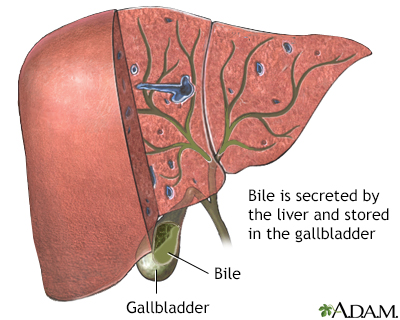Biliary atresia
Jaundice newborns - biliary atresia; Newborn jaundice - biliary atresia; Extrahepatic ductopenia; Progressive obliterative cholangiopathy
Biliary atresia is a blockage in the tubes (ducts) that carry a liquid called bile from the liver to the gallbladder.
Images

Causes
Biliary atresia occurs when the bile ducts inside or outside the liver are abnormally narrow, blocked, or absent. The bile ducts carry a digestive fluid from liver to small bowel to break down fats and filter out waste from the body.
The cause of the disease is not clear. It may be due to:
- Viral infection after birth
- Exposure to toxic substances
- Multiple genetic factors
- Perinatal injury
- Some medicines such as carbamazepine
It more commonly affects people of East Asian and African-American descent.
The bile ducts help remove waste from the liver and carry salts that help the small intestine break down (digest) fat.
In babies with biliary atresia, bile flow from the liver to the gallbladder is blocked. This can lead to liver damage and cirrhosis of the liver, which can be deadly.
Symptoms
Symptoms usually start to occur between 2 to 8 weeks. Jaundice (a yellow color to the skin and mucus membranes) develops slowly 2 to 3 weeks after birth. The infant may gain weight normally for the first month. After that point, the baby will lose weight and become irritable, and will have worsening jaundice.
Other symptoms may include:
Exams and Tests
Your health care provider will take medical history of your child and do a physical exam to check for enlarged liver.
Tests to diagnose biliary atresia include:
- Abdominal x-ray to check for enlarged liver and spleen
- Abdominal ultrasound to check internal organs
- Blood tests to check total and direct bilirubin levels
- Hepatobiliary scintigraphy or HIDA scan to check whether the bile ducts and gallbladder are working properly
- Liver biopsy to check the severity of cirrhosis or to rule out other causes of jaundice
- X-ray of the bile ducts (cholangiogram) to check if the bile ducts are opened or closed
Treatment
An operation called the Kasai procedure is done to connect the liver to the small intestine. The abnormal ducts are bypassed. The surgery is more successful if done before the baby is 8 weeks old.
Liver transplant may still be needed before 20 years of age in most of the cases.
Outlook (Prognosis)
Early surgery will improve the survival of more than one third of babies with this condition. The long-term benefit of a liver transplant is not yet known, but it is expected to improve survival.
Possible Complications
Complications may include:
- Infection
- Irreversible cirrhosis
- Liver failure
- Surgical complications, including failure of the Kasai procedure
When to Contact a Medical Professional
Contact your provider if your child appears jaundiced, or if other symptoms of biliary atresia develop.
Related Information
BileBiliary system
Cirrhosis
Weight loss - unintentional
Newborn jaundice - what to ask your doctor
Newborn jaundice - discharge
References
Berlin SC. Diagnostic imaging of the neonate. In: Martin RJ, Fanaroff AA, Walsh MC, eds. Fanaroff and Martin's Neonatal-Perinatal Medicine. 11th ed. Philadelphia, PA: Elsevier; 2020:chap 38.
Cazares J, Ure B, Yamataka A. Biliary atresia. In: Holcomb GW, Murphy JP, St. Peter SD, eds. Holcomb and Ashcraft's Pediatric Surgery. 7th ed. Philadelphia, PA: Elsevier; 2020:chap 43.
Kliegman RM, St. Geme JW, Blum NJ, Shah SS, Tasker RC. Cholestasis. In: Kliegman RM, St. Geme JW, Blum NJ, Shah SS, Tasker RC, Wilson KM, eds. Nelson Textbook of Pediatrics. 21st ed. Philadelphia, PA: Elsevier; 2020:chap 383.
O'Hara SM. The pediatric liver and spleen. In: Rumack CM, Levine D, eds. Diagnostic Ultrasound. 6th ed. Philadelphia, PA: Elsevier; 2024:chap 52.
BACK TO TOPReview Date: 2/17/2024
Reviewed By: Charles I. Schwartz, MD, FAAP, Clinical Assistant Professor of Pediatrics, Perelman School of Medicine at the University of Pennsylvania, General Pediatrician at PennCare for Kids, Phoenixville, PA. Also reviewed by David C. Dugdale, MD, Medical Director, Brenda Conaway, Editorial Director, and the A.D.A.M. Editorial team.

Health Content Provider
06/01/2025
|
A.D.A.M., Inc. is accredited by URAC, for Health Content Provider (www.urac.org). URAC's accreditation program is an independent audit to verify that A.D.A.M. follows rigorous standards of quality and accountability. A.D.A.M. is among the first to achieve this important distinction for online health information and services. Learn more about A.D.A.M.'s editorial policy, editorial process and privacy policy. A.D.A.M. is also a founding member of Hi-Ethics. This site complied with the HONcode standard for trustworthy health information from 1995 to 2022, after which HON (Health On the Net, a not-for-profit organization that promoted transparent and reliable health information online) was discontinued. |
The information provided herein should not be used during any medical emergency or for the diagnosis or treatment of any medical condition. A licensed medical professional should be consulted for diagnosis and treatment of any and all medical conditions. Links to other sites are provided for information only -- they do not constitute endorsements of those other sites. © 1997- 2025 A.D.A.M., a business unit of Ebix, Inc. Any duplication or distribution of the information contained herein is strictly prohibited.
